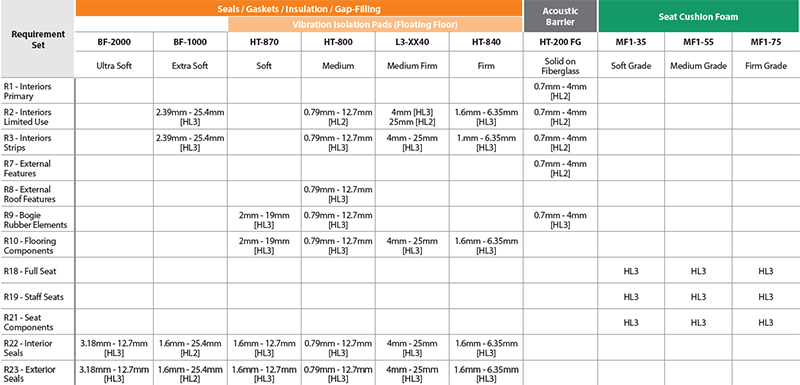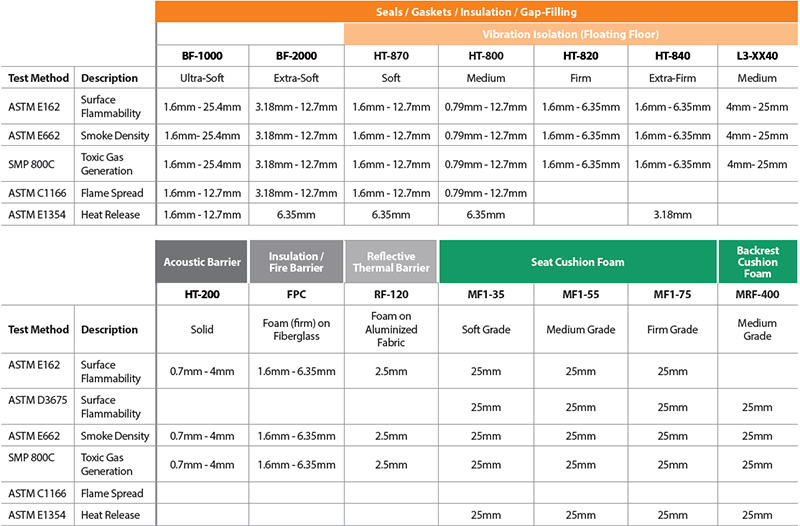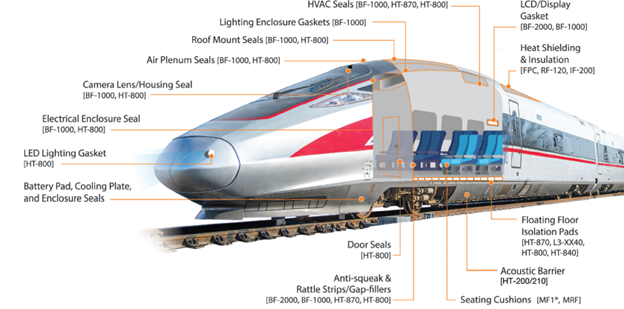
由罗杰斯公司发布
企业
想象一下高峰时段挤满乘客的高速列车。
突然,电气故障引发了小火情。
如果没有合适的防火材料,火灾可能会迅速蔓延,释放出有毒烟雾,危及列车上的生命。
然而,如果材料能够符合严格的轨道行业防火安全规范,火灾可以得到遏制,从而实现安全疏散并挽救生命。
该场景展示了可靠合规的材料在轨道应用中的关键作用。在罗杰斯公司,我们不仅满足这些严格的要求,还实现了超越。我们的材料可提高全球轨道交通系统的安全性,并增强可靠性和舒适性。
在本博客中,我们将探讨关键的轨道行业规范,如 EN 45545-2 和 NFPA 130,并着重介绍罗杰斯的创新材料如何超越这些标准。此外,还将探讨我们的高性能材料在轨道行业的关键应用。
EN 45545-2 和 49CFR238/NFPA 130 轨道交通防火安全标准是什么?
罗杰斯公司的工程材料经过专门设计,符合并超越全球轨道安全标准,包括 49CFR238/NFPA 130 和 EN 45545-2。超越这些标准意味着材料不仅满足当前的法规要求,而且在极端条件下能够提供增强的性能,并具有更高的安全性。这有助于提高轨道系统的长期可靠性和运行效率。
EN 45545-2:欧洲轨道交通防火安全标准
EN 45545-2 是轨道车辆制造中所使用材料的强制性欧洲标准。该标准旨在保护乘客和乘务人员免受轨道车辆中的火灾。其中规定了火灾风险等级和材料组的测试方法和性能标准。
主要目标是最大限度地降低火灾风险并确保乘客安全,实现方式是设定以下方面的严格标准:
- 火焰传播
- 热释放率
- 烟雾密度
- 燃烧时的有毒气体
该标准根据轨道车的预期用途指定危险等级,并进一步对应用和要求进行分类。材料要求(R1,R2...)取决于列车车型(HL 等级)和产品分类 (IN1A,EC2)。有关详细信息,请参阅下图。
| 危险等级分类 HL1, HL2, HL3 |
产品分类 IN1A, EX2, F1... |
要求 R1, R2, R3... |
|---|---|---|
|
|
|
哪些罗杰斯材料符合 EN 45545-2 标准?
我们的材料经过严格测试,符合并超出这些标准,为轨道行业提供可靠的防火安全解决方案。
符合 EN 45545-2 标准的罗杰斯材料包括 BISCO® HT-800、BISCO® HT-200 和 BISCO® HT-6360。

49CFR238/ NFPA 130:北美防火安全标准
49CFR238/NFPA 130 是北美的阻燃、低烟、低毒标准 (FST)。该标准规定了地下、地面和高架固定导轨运输和客运轨道系统的防火和生命安全要求。NFPA 130 的主要方面包括:
- 材料的耐火性
- 烟雾管理
- 紧急出口
- 振动和噪音控制
NFPA 130 合规性涉及的关键测试包括:
| ASTM E162 表面阻燃性 | 此测试方法对暴露于规定水平的辐射热能时的材料表面阻燃性进行测量和比较。用于测量暴露于火灾的材料表面阻燃性。 |
| ASTM E662 烟雾密度 | 本试验方法提供了一种方式,用于确定材料和组件试样在指定暴露条件下产生的烟雾的比光密度。 |
| SMP 800-C 有毒气体生成 | Bombardier SMP 800-C 测量轨道车构造中使用的材料燃烧产生的有毒气体。 |
| ASTM C1166 火焰传播 | 此测试方法旨在区分垫圈、定位块、填隙片或垫片中使用的致密或多孔结构高弹体化合物的火焰传播特性。 |
| ASTM E1354 散热 | 此测试方法主要用于确定涉及试验材料产品的火灾中产生的热量或促成的热量。还包括有效热燃烧、质量损失率、持续燃烧时间和烟雾产生的测定。 |
| ASTM D3675 表面阻燃性 | 本测试方法适用于测量暴露于火灾的柔性多孔结构材料的表面阻燃性。 |
哪些罗杰斯材料符合 49CFR238/ NFPA 130 标准?
符合 49CFR238/ NFPA 130 标准的罗杰斯材料为 BISCO MF1、HT-800、L3 和 HT-200。

为什么防火安全标准对现代轨道车设计很重要
满足 EN 45545-2 和 49CFR238/NFPA 130 等防火安全标准对于确保轨道车辆中的乘客安全性和系统可靠性至关重要。这些标准有助于在门、暖通空调系统和乘客舱等关键区域降低火灾、烟雾和毒气排放风险。通过遵守这些法规,设计师可以保护乘客,同时确保轨道系统的长期可靠性和安全性。
罗杰斯材料符合轨道交通标准
罗杰斯公司材料的设计以创新和可靠性为宗旨。我们的轨道交通材料产品组合经过设计和测试,可满足并超越全球轨道交通标准的苛刻要求。
我们不断测试自己的材料是否符合阻燃、低烟和低毒要求,以确保这些材料在最恶劣条件下的性能。无论您的项目位于何处,罗杰斯都能提供符合 EN 45545-2、NFPA 130 和其他全球轨道交通标准的防火解决方案。
轨道应用关键领域
罗杰斯高性能材料支持各种内部和外部轨道应用,提高了安全性、耐久性和乘客舒适度。我们的一些关键应用领域包括:
- 暖通空调密封
- 屋顶安装密封
- 门封
- 电气/外壳密封
噪音、振动和防异响管理
垫圈
其他
应用于轨道车辆的 BISCO 硅胶材料解决方案
为什么选择罗杰斯作为轨道交通安全解决方案?
为轨道应用选择合适的材料对于提高安全性、合规性和乘客舒适度至关重要。罗杰斯公司的创新材料旨在满足最严格的标准,包括 EN 45545-2 和 NFPA 130,同时提供可靠性、高性能和多功能性。
当您选择罗杰斯时,您可以确信您的轨道项目可以从我们数十年的专业知识、严格测试和安全保证中受益。
详细了解罗杰斯材料如何为您的轨道应用带来优势,或联系我们知识渊博的销售工程师。
让我们共同努力,提高安全性、可靠性和性能。
相关内容
标签:
轨道交通
发布于 2024 年 11 月 11 日



